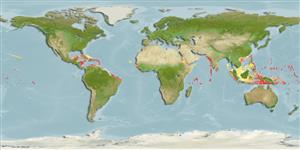Common names from other countries
>
Anguilliformes (Eels and morays) >
Muraenidae (Moray eels) > Uropterygiinae
Etymology: Channomuraena: Greek, chanos, -eos, ous, and chasma, -atos = abyss, mouth opened, inmensity + Latin, muraena = morey eel (Ref. 45335).
More on author: Richardson.
Environment: milieu / climate zone / depth range / distribution range
Ecología
marino asociado a arrecife; rango de profundidad 5 - 100 m (Ref. 5217), usually 7 - 37 m (Ref. 37816). Tropical; 24°N - 11°S
Circumtropical. Indian Ocean: Reunion and Mauritius (Ref. 33390) and Christmas Island. Western Pacific: Palau, and the Hawaiian Islands. Western Atlantic: Bermuda, Bahamas, and Caribbean Sea; may occur in southern Florida, USA and northwestern Gulf of Mexico (Ref. 7251). Reported from Bahia, Brazil (Ref. 57756). Eastern Atlantic: around oceanic islands.
Tamaño / Peso / Age
Maturity: Lm ? range ? - ? cm
Max length : 150 cm TL macho / no sexado; (Ref. 37816); common length : 80.0 cm TL macho / no sexado; (Ref. 5217)
Espinas dorsales (total) : 0; Radios blandos dorsales (total) : 0; Espinas anales: 0; Radios blandos anales: 0. The small cranium, anterior position of the eyes, and enlarged lower jaw are unique (Ref 1602)
A benthic species and solitary species (Ref. 26340) inhabiting outer reef slopes. Occurs under ledges and in holes of reef slopes (Ref. 37816). Has the habit of puffing its head like a cobra when approached (Ref. 37816). Secretive and nocturnal (Ref. 48635). Minimum depth reported taken from Ref. 30874.
Life cycle and mating behavior
Maturities | Reproducción | Spawnings | Egg(s) | Fecundities | Larva
Böhlke, J.E., 1981. Muraenidae. In W. Fischer, G. Bianchi and W.B. Scott (eds.) FAO species identification sheets for fishery purposes. Eastern Central Atlantic, (Fishing Areas 34, 47 (in part)), Vol. 3. [var. pag.]. FAO, Rome. (Ref. 3254)
IUCN Red List Status (Ref. 130435)
CITES (Ref. 128078)
Not Evaluated
Threat to humans
Harmless
Human uses
Pesquerías: pesquerías de subsistencia; Acuario: Comercial
Herramientas
Special reports
Download XML
Fuentes de Internet
Estimates based on models
Preferred temperature (Ref.
115969): 25.5 - 28.9, mean 27.7 (based on 388 cells).
Phylogenetic diversity index (Ref.
82804): PD
50 = 0.7500 [Uniqueness, from 0.5 = low to 2.0 = high].
Bayesian length-weight: a=0.00069 (0.00033 - 0.00144), b=3.12 (2.93 - 3.31), in cm Total Length, based on LWR estimates for this (Sub)family-body shape (Ref.
93245).
Nivel trófico (Ref.
69278): 4.0 ±0.66 se; based on food items.
Resiliencia (Ref.
120179): Muy bajo, población duplicada en un tiempo mínimo superior a 14 años (Preliminary K or Fecundity.).
Fishing Vulnerability (Ref.
59153): Very high vulnerability (90 of 100).
